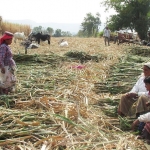Biosafety Protocol Watered Down by U.S. Interests?
The Biosafety Protocol has finally been adopted in the hope that it will bring some transparency into the trade in genetically-modified products. But some say it is weak and watered down to suit US interests
For the first time ever, an international framework has been set up to
regulate the trade in genetically-modified (GM) products. Following a week of intense negotiations in Montreal, Canada, delegates from over 140 countries framed rules which will allow countries to ban the import of GM seeds, microbes, animals and crops that they believe is harmful to their environment. The pact also stipulates that all GM food must bear the label 'may contain' before they are shipped to other countries.
Called the Cartagena Protocol on Biosafety, as it was in this city of Colombia where the talks began and were suspended a year ago, it will take effect after it is ratified by at least 50 countries.
The term genetically-modified refers to plants and animals containing genes transferred from other species to produce certain characteristics, such as resistance to certain pests and herbicides. But fears about GM organisms remain. For instance, genes that make crops herbicide-resistant could spread by pollination to weak relatives, creating 'superweeds'. Or genes injected in fish, to make them grow faster, might affect the native fish population in their efforts to find food or mates.
Trade, not environment
However, the road to the setting up of this protocol has not been smooth.
The US position on GM food throughout the negotiations was governed by its trade policies, and not environment protection. In February 1999, the US blocked the first attempt to reach an agreement in Cartagena, fearing that the agreement was too broad and would damage trade in commodities such as corn and soybean, a large amount of which is GM.
Ironically, the US is not a signatory to the pact as the US Congress is yet to ratify the Convention on Biological Diversity which was forged in Rio de Janeiro in 1992, and is a precursor to the current agreement. At the talks, the US had an 'observer' status and could not vote or officially participate. Despite this, it was able to influence the talks through its agricultural allies, Canada and Australia. However, it will still have to comply with the rules when exporting to countries that are parties to the protocol.
Weak Links in the Chain The protocol and its limitations | |
Strengths
| Weaknesses
|
Many analysts feel that the pact has been watered down to suit US trade interests. For instance, GM product labels will just say 'may contain' and not specific details on what GM materials are in the shipment. Had it
been so, it would have affected major US grain exporters such as Cargill Inc and Archer-Daniels-Midland Co. Many European delegates and environmentalists complained that the pact had been unduly weakened. The protocol also does not include labelling of grain or animals once they are processed into food products such as flour or cooking oil. For example, cornflakes made from GM corn will not be labelled when they appear on store shelves.
However, the good news for the developing countries was the inclusion of the so-called Precautionary Principle, which states that a country can take action to protect itself by barring import of a GM organism, even if there is a lack of scientific data that it could be dangerous. In fact, many European and developing countries wanted the pact to supersede World Trade Organisation (WTO) rules. That is because under WTO rules, an import can be banned only on the basis of scientific evidence. The US fought for its inclusion fearing that countries could ban GM food products at will. But this was rejected by the delegates. During the negotiations, the US and several other nations said that enforcing the Precautionary Principle too strongly would allow countries to ban imports of GM food simply because of fear or protectionism.
But there seems to be a catch. The agreement contains a 'savings clause,' wherein the new pact will not override rights and obligations under other international agreements, including the WTO. The US insisted that science-based WTO rules would still apply to import decisions. "If a dispute arises over a country's decision to close its market to a food product, the WTO will review the protocol before making a ruling," said Margot Wallstrom, European Commission environment minister.
The protocol also establishes a biosafety 'clearing house' for countries to share information about GM organisms. Countries must inform the 'clearing house' within 15 days of approval of any crop varieties which could be used in food, animal feed and processing.
What it means for India
The Indian government believes that the protocol will not affect the
country. R H Khwaja, joint secretary, ministry of environment and forests (MEF) who led the Indian delegation at the meet, said: "India has the legislation covering biotechnology which came into effect in 1989." But some experts have a different opinion. Suman Sahai, convenor of the Delhi-based non-governmental organisation, Gene Campaign, says that in the absence of adequate labelling, developing countries like India will become a dumping ground for tonnes of GM food waiting to be exported from Canada, Australia and the US. In a press statement, she said that there are reasons to be concerned because a shipment of GM maize was mixed with the maize imported from the US to India last year.
Moreover, developing countries, that are rich in diversity, should be careful of genetic pollution: foreign genes from GM crops could get mixed with wild relatives of crop plants. And if they contain sterile seed technologies, seed production of major crops will shift into the hands of foreign biotech companies that possess 'terminator' technologies, adds Sahai.
Sahai says that developing countries must now focus their attention on formulating domestic rules and guidelines to check any move to import GM food. However, the controversy over GM food, its environment implications and health effects has not ended. As Juan Mayr, Colombia's environment minister, said at the end of the negotiations, "This is just the beginning. We have still a great challenge ahead of us."
- 181 Food and Agriculture



